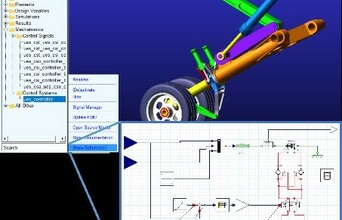
Having introduced Elements, new simulation software, Hexagon's Manufacturing Intelligence division aims at helping engineering teams understand the behaviour of systems that appear too complex in modern products. This software can evaluate the team performances and feasibility of new design concepts quickly to observe more efficient product development and reduce risk as well as cost of producing goods.
Elements address the growing importance of integrated, multi-disciplinary system development and end-to-end workflows in the manufacturing industry. Customers in every industry demand modern manufacturing technologies that study many physics domains and deal with mechatronics challenges in a robust way, fuelling a growing trend towards large-scale system-level engineering. Achieving this requires the integration of all relevant engineering disciplines, control systems, and third-party supplier systems to understand how the domains interact, and how a design decision in one discipline impacts others.
The Elements software is easy for systems engineers to learn and use, using its drag-and-drop environment to model any physics type or logic and analyse systems by intuitively connecting blocks - regardless of whether they represent electrical, or hydraulic, mechanical components - to solve system-level engineering problems. It is based on the Modelica language, an open and widely used standard for building fast, flexible, and customisable models.
Systems modelling is an important process in the early design phases that requires only a little information concerning CAD model, equation, or lookup table while information on a 3D mesh is not required. Elements further ensure the quick and efficient computation of system-level models by optimising equations and code for fast calculation, thus boosting engineering development and the manufacturing production process. As the design develops, and components and subsystems are detailed in specialist simulation software, the components can be routinely integrated into a larger system through full compliance with the FMI standard and Hexagon's proprietary SmartFMU technology. SmartFMU unlocks the Functional Mock-up Unit (FMU) for supported Hexagon products so that changes can be made directly in the Elements system-level model without going back to the specialist Computer Aided Engineering (CAE) software and its expert user. This will avoid resource blockage, time-consuming switching between applications, and versioning problems.
Hexagon's strategic journey in the manufacturing sector includes best-in-class CAE technologies readied for easy and productive use with Elements. At launch, the software provides SmartFMU connectivity with Adams multi-body dynamics software and Easy5. Future plans would include vision schemes with Cradle CFD thermal-fluid dynamics and Actran acoustic simulation products, among others.
Both standard FMI support and the novel SmartFMU plug-and-play capabilities provide immediate value and solutions to challenges of system complexity, including those for transportation electrification, for example:
• Finding solutions to vehicle range optimisation issues by considering a vehicle's energy use under different driving conditions, taking into account eDrive design, regenerative braking, climate control, ADAS safety requirements, and battery choice.
• Improving the flexibility and accuracy of industrial robotics by designing control systems considering detailed mechanical system vibrations and interactions from multi-body dynamics simulation.
• Right-sizing heavy battery systems in new eVTOL aircraft designs by helping engineers understand the power draw during take-off and landing, safety margins, and thermal management system controls.
• Implementing safer, more sustainable long-life battery systems by using Elements to design control systems that balance the improved performance of lithium-ion batteries at elevated temperatures with the impact heating has on cell degradation in the finished product.
Elements was developed in collaboration with Maplesoft.
Mahesh Kailasam, General Manager, Design and Engineering Software, Hexagon, commented, "Elements offers engineers an easy way to explore the behaviour of systems quickly and find better solutions to problems using simulation, before committing designs to subsequent resource-intensive engineering processes. We look forward to a long-term collaboration with Maplesoft, using its powerful and open technology foundations to realise synergies with our extensive Hexagon CAE ecosystem portfolio and deliver valuable capabilities to our customers."



























